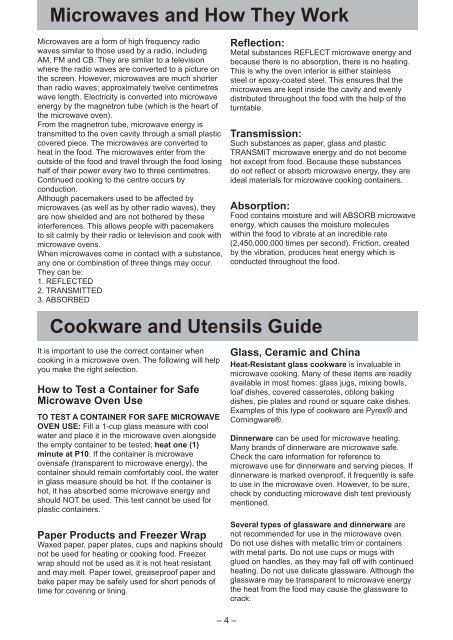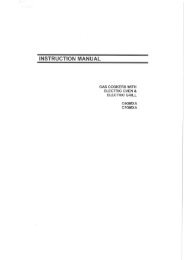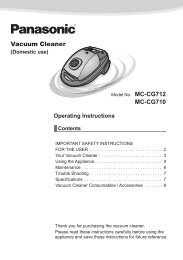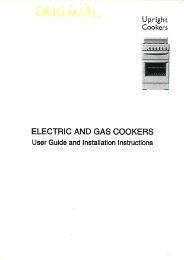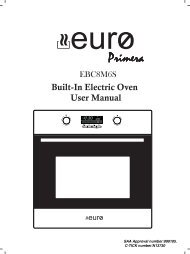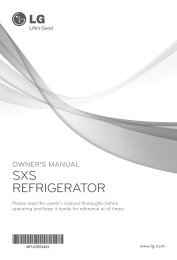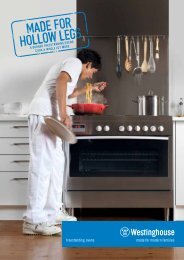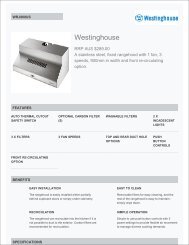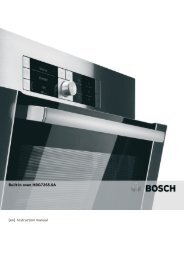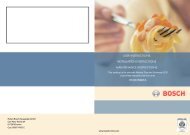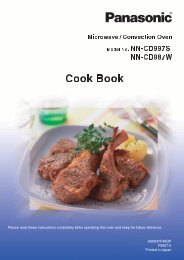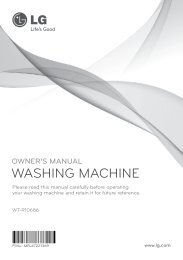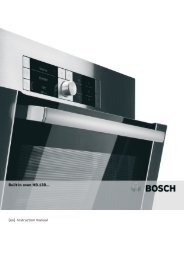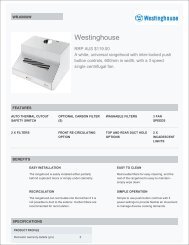Panasonic NN-ST671S 32Litre Microwave User Manual Download
Panasonic NN-ST671S 32Litre Microwave User Manual Download
Panasonic NN-ST671S 32Litre Microwave User Manual Download
Create successful ePaper yourself
Turn your PDF publications into a flip-book with our unique Google optimized e-Paper software.
<strong>Microwave</strong>s and How They Work<br />
<strong>Microwave</strong>s are a form of high frequency radio<br />
waves similar to those used by a radio, including<br />
AM, FM and CB. They are similar to a television<br />
where the radio waves are converted to a picture on<br />
the screen. However, microwaves are much shorter<br />
than radio waves; approximately twelve centimetres<br />
wave length. Electricity is converted into microwave<br />
energy by the magnetron tube (which is the heart of<br />
the microwave oven).<br />
From the magnetron tube, microwave energy is<br />
transmitted to the oven cavity through a small plastic<br />
covered piece. The microwaves are converted to<br />
heat in the food. The microwaves enter from the<br />
outside of the food and travel through the food losing<br />
half of their power every two to three centimetres.<br />
Continued cooking to the centre occurs by<br />
conduction.<br />
Although pacemakers used to be affected by<br />
microwaves (as well as by other radio waves), they<br />
are now shielded and are not bothered by these<br />
interferences. This allows people with pacemakers<br />
to sit calmly by their radio or television and cook with<br />
microwave ovens.<br />
When microwaves come in contact with a substance,<br />
any one or combination of three things may occur.<br />
They can be:<br />
1. REFLECTED<br />
2. TRANSMITTED<br />
3. ABSORBED<br />
Reflection:<br />
Metal substances REFLECT microwave energy and<br />
because there is no absorption, there is no heating.<br />
This is why the oven interior is either stainless<br />
steel or epoxy-coated steel. This ensures that the<br />
microwaves are kept inside the cavity and evenly<br />
distributed throughout the food with the help of the<br />
turntable.<br />
Transmission:<br />
Such substances as paper, glass and plastic<br />
TRANSMIT microwave energy and do not become<br />
hot except from food. Because these substances<br />
do not refl ect or absorb microwave energy, they are<br />
ideal materials for microwave cooking containers.<br />
Absorption:<br />
Food contains moisture and will ABSORB microwave<br />
energy, which causes the moisture molecules<br />
within the food to vibrate at an incredible rate<br />
(2,450,000,000 times per second). Friction, created<br />
by the vibration, produces heat energy which is<br />
conducted throughout the food.<br />
Cookware and Utensils Guide<br />
It is important to use the correct container when<br />
cooking in a microwave oven. The following will help<br />
you make the right selection.<br />
How to Test a Container for Safe<br />
<strong>Microwave</strong> Oven Use<br />
TO TEST A CONTAINER FOR SAFE MICROWAVE<br />
OVEN USE: Fill a 1-cup glass measure with cool<br />
water and place it in the microwave oven alongside<br />
the empty container to be tested; heat one (1)<br />
minute at P10. If the container is microwave<br />
ovensafe (transparent to microwave energy), the<br />
container should remain comfortably cool, the water<br />
in glass measure should be hot. If the container is<br />
hot, it has absorbed some microwave energy and<br />
should NOT be used. This test cannot be used for<br />
plastic containers.<br />
Paper Products and Freezer Wrap<br />
Waxed paper, paper plates, cups and napkins should<br />
not be used for heating or cooking food. Freezer<br />
wrap should not be used as it is not heat resistant<br />
and may melt. Paper towel, greaseproof paper and<br />
bake paper may be safely used for short periods of<br />
time for covering or lining.<br />
Glass, Ceramic and China<br />
Heat-Resistant glass cookware is invaluable in<br />
microwave cooking. Many of these items are readily<br />
available in most homes: glass jugs, mixing bowls,<br />
loaf dishes, covered casseroles, oblong baking<br />
dishes, pie plates and round or square cake dishes.<br />
Examples of this type of cookware are Pyrex® and<br />
Corningware®.<br />
Dinnerware can be used for microwave heating.<br />
Many brands of dinnerware are microwave safe.<br />
Check the care information for reference to<br />
microwave use for dinnerware and serving pieces. If<br />
dinnerware is marked ovenproof, it frequently is safe<br />
to use in the microwave oven. However, to be sure,<br />
check by conducting microwave dish test previously<br />
mentioned.<br />
Several types of glassware and dinnerware are<br />
not recommended for use in the microwave oven.<br />
Do not use dishes with metallic trim or containers<br />
with metal parts. Do not use cups or mugs with<br />
glued on handles, as they may fall off with continued<br />
heating. Do not use delicate glassware. Although the<br />
glassware may be transparent to microwave energy<br />
the heat from the food may cause the glassware to<br />
crack.<br />
– 4 –


